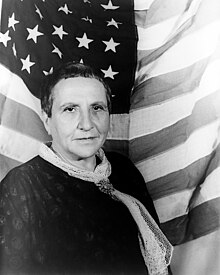
Back جيرترود شتاين Arabic جيرترود شتاين ARZ Gertrude Stein AVK قرترود استاین AZB Гертруда Стайн Byelorussian Гертруда Стайн BE-X-OLD Гъртруд Стайн Bulgarian গারট্রুড স্টেইন Bengali/Bangla Gertrude Stein Catalan Gertrude Steinová Czech
Gertrude Stein | |
|---|---|
 Portrait by Carl Van Vechten, 1935 | |
| Born | February 3, 1874 Allegheny, Pennsylvania, U.S. |
| Died | July 27, 1946 (aged 72) Neuilly-sur-Seine, France |
| Resting place | Père Lachaise Cemetery |
| Occupation |
|
| Education | Harvard University (BA) Johns Hopkins University |
| Literary movement | Modernist literature |
| Partner | Alice Toklas |
| Signature | |
 | |
Gertrude Stein (February 3, 1874 – July 27, 1946) was an American novelist, poet, playwright, and art collector. Born in Allegheny, Pennsylvania (now part of Pittsburgh), and raised in Oakland, California,[1] Stein moved to Paris in 1903, and made France her home for the remainder of her life. She hosted a Paris salon, where the leading figures of modernism in literature and art, such as Pablo Picasso, Ernest Hemingway, F. Scott Fitzgerald, Sinclair Lewis, Ezra Pound, Sherwood Anderson and Henri Matisse, would meet.[2][3][4]
In 1933, Stein published a quasi-memoir of her Paris years, The Autobiography of Alice B. Toklas, written in the voice of Alice B. Toklas, her life partner. The book became a literary bestseller and vaulted Stein from the relative obscurity of the cult-literature scene into the limelight of mainstream attention.[5] Two quotes from her works have become widely known: "Rose is a rose is a rose is a rose",[6] and "there is no there there", with the latter often taken to be a reference to her childhood home of Oakland.[7]
Her books include Q.E.D. (1903), about a lesbian romantic affair involving several of Stein's friends; Fernhurst, a fictional story about a love triangle; Three Lives (1905–06); The Making of Americans (1902–1911); and Tender Buttons (1914).
Her activities during World War II have been the subject of analysis and commentary. As a Jew living in Nazi-occupied France, Stein may have only been able to sustain her lifestyle as an art collector, and indeed to ensure her physical safety, through the protection of the powerful Vichy government official and Nazi collaborator Bernard Faÿ. After the war ended, Stein expressed admiration for another Nazi collaborator, Vichy leader Marshal Pétain.[8][9]
- ^ "Gertrude Stein's Oakland". HuffPost. May 31, 2012. Retrieved January 16, 2024.
- ^ Pound, Cath (July 26, 2021). "The shocking memoir of the 'lost generation'". BBC. Retrieved March 5, 2023.
- ^ Haas, Brenda (July 26, 2021). "Gertrude Stein: A complex pioneer of modernism". Deutsche Welle. Retrieved March 5, 2023.
- ^ "Extravagant Crowd: Gertrude Stein and Alice B. Toklas". Retrieved October 16, 2012.
- ^ Mellow, James R. (May 3, 1998). "The Stein Salon Was The First Museum of Modern Art". The New York Times. Retrieved October 13, 2012.
- ^ Fritz Monade (August 23, 2013). "Natias Neutert about Gertrude Stein´s Rose". www.youtube.com.
- ^ "Gertrude Stein's Oakland". HuffPost. May 31, 2012. Retrieved January 16, 2024.
- ^ Barbara Will. HUMANITIES, March/April 2012, Volume 33, Number 2:The Strange Politics of Gertrude Stein.
- ^ Cite error: The named reference
ReferenceAwas invoked but never defined (see the help page).